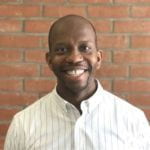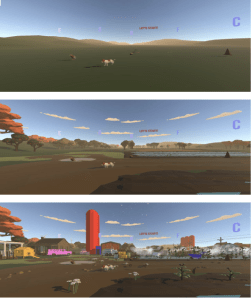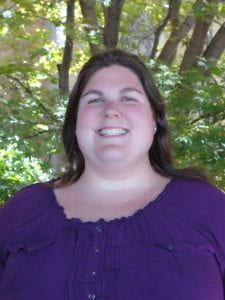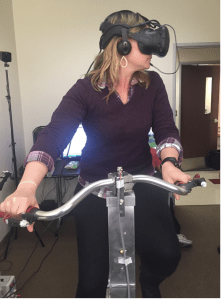Dr. Lisa Aziz-Zadeh
School: Brain and Creativity Institute
Lab: The Center for the Neuroscience of Embodied Cognition (CeNEC)
Current Project:
Otherness and Belonging
Belonging is a fundamental relationship grounded in the interaction between an organism and its world. It is always a multi-directional relation where the world includes the social, physical, emotional, and cultural environment available to the organism. For human beings, belonging is a critical factor both in the creation and in the perception of meaning in life. It is just as important as food or water for our survival and well-being. A lack of belonging is an existential breakage in a human being’s relationship to their environment and to the world and is a fundamental human need (Maslow, 1943). From an evolutionary perspective, the predisposition to belong is central to human existence and culture. Personality traits that motivate individuals to gain acceptance and avoid rejection are indispensable tools enabling survival and reproduction. The goal of the current project is to understand the basic science underlying human need and the multiple dimensions of belonging, and to provide data on bridging strategies that mitigate the feeling of otherness. Data generated by this project will inform intervention strategies. It is a collaboration between the USC CeNEC lab, the UC Berkeley Othering and Belonging Institute, and Google.

Dr. James Finley
In the USC Locomotor Control Lab, we seek to understand how walking is controlled and adapted in both the healthy and injured neuromuscular system. We develop models and experiments based on principles of neuroscience, biomechanics, engineering, and exercise physiology to identify the factors that guide locomotor learning and rehabilitation. Ultimately, the goal of our work is to design novel and effective interventions to improve walking ability in individuals with damage to the nervous system.
Individuals with neurological impairments such as stroke or Parkinson’s disease (PD) commonly have gait impairments that reduce their ability to walk safely in the community. These impairments are characterized by a compromised ability to turn and difficulty negotiating both predictable and unpredictable environments. As a result, these individuals are much more likely to fall than healthy age-matched controls, with tripping over obstacles being commonly identified as a major cause of falls. Thus, it is critical to train skills such as turning and obstacle avoidance to maximize functional gait ability. The use of virtual environments allows us to tailor each patient’s training context to match the obstacles and barriers they face on a daily basis in a safe, well-controlled setting.
Ongoing Projects:
Design and Development of a Fully Immersive Virtual-Reality System for Improving Skilled Walking Ability
Despite our understanding that training skills such as turning and obstacle avoidance are necessary to maximize functional mobility, gait interventions often focus on walking along an unobstructed path in a straight line. Existing interventions may also fail to integrate principles of skill training, which are known to facilitate long-term improvements in motor skill (e.g., progressive increase in difficulty , focus on skillful movement, promoting independence). To address this limitation, we are developing and testing the usability of a multi-platform training system that allows individuals with Parkinson's disease to practice advanced walking skills such as turning and obstacle avoidance in real-world scenarios. We are relying on a user-centered approach to address the limitations of previous approaches to virtual-reality-based training in order to achieve a training experience that is meaningful to the end-user (patients and therapists). A key innovation of our approach is that our system can be used either with standard treadmills, over-ground in an open space, or in conjunction with newer, omni-directional treadmills.
Principles of Locomotor Skill Learning in Real and Virtual Environments
Recent advances in consumer-grade technology for virtual reality have lowered the barriers to widespread use of VR for clinical applications such as a neuromotor rehabilitation. However, in order to optimize the design and implementation of VR-based interventions, it is important to understand the fundamental processes underlying motor skill learning in virtual environments and the factors that influence whether skills learned in virtual environments will generalize in the real world. In addition to understanding how conditions of practice influence skill acquisition, retention, and transfer, we also seek to understand what neural networks are involved with locomotor skill learning in healthy individuals and how damage to these networks in pathological populations influences the learning process.
VR-based Assessments of Cognitive-Motor Function
Selecting and attending to relevant visual information from the environment is essential for planning and executing everyday tasks. The control of visual attention is often described as an interaction between salient bottom-up and cognitive top-down mechanisms. Saliency embodies characteristics of visual stimuli such as contrast and luminance that capture attention involuntarily (bottom-up), while cognitive factors such as prior knowledge and task demands drive attention voluntarily (top-down). Aging-related cognitive impairments are thought to bias attention towards salient stimuli, making older adults more susceptible to visual distractions. However, the extent to which this saliency bias is present in complex environments remains to be determined. Here, we are using interactions with virtual environments to determine the age-dependent effects of scene complexity on visual attention and task performance in older adults. These interactive experiences could potentially be used to assess the presence of cognitive impairments that could negatively impact people's ability to process visual information when interacting with complex environments.


The Haptics Robotics and Virtual Interaction (HaRVI) Laboratory explores how humans interact with our world, robots, and technology through touch. The goal of our research is to create natural and intuitive interactions that realistically mimic the touch sensations experienced during interactions with the physical world. We design novel haptic hardware and rendering algorithms to improve the usability of technology, increasing people’s social connectedness, ability to complete specific tasks, and immersiveness in virtual reality. Our research has a strong focus on integrating human perception into all steps of the design process.
Simulator sickness prevents many individuals from using virtual reality (VR) systems, especially when moving around a virtual environment. Different theories have sought to determine the causes for such sickness, with proposed causes including sensory conflicts, vection conflicts, and eye movement theories. We have created a floor vibrotactile feedback system that provides vibration to mimic the cues received at the feet during walking. By providing such sensory replacement that matches vestibular cues to visual cues, our system reduces motion sickness.


The NPNL at USC is an interdisciplinary lab situated between the Chan Division of Occupational Science and Occupational Therapy, the Division of Biokinesiology and Physical Therapy, the Keck School of Medicine Department of Neurology, and the Neuroscience Graduate Program and affiliated with the USC Mark and Mary Stevens Neuroimaging and Informatics Institute and the USC Brain and Creativity Institute. We are scientists and researchers with varied backgrounds across neuroscience, cognitive science, engineering, computer science, occupational therapy, and physical therapy.
Virtual and augmented reality are promising ways to promote embodiment of avatars different from ourselves. In the case of stroke, we ask whether embodiment of a virtual avatar controlled by one’s brain signals can enhance motor recovery. In healthy individuals, we ask whether virtual reality can enhance learning and decision making. We have several initiatives in this area:
Ongoing Projects:
REINVENT
Virtual reality also gives people an opportunity to have a virtual body that’s different from their real body. Studies have shown that if we’re given a body with extra long arms in virtual reality, we act as though we really have long arms in the real world, and if we’re given a child’s body in virtual reality, we show more child-like behaviors. In our project called REINVENT (Rehabilitation Environment using the Integration of Neuromuscular-based Virtual Enhancements for Neural Training), we are trying to give people who have difficulty moving their arm after stroke a healthy body in virtual reality. Their healthy body in VR is controlled using their own brain and muscle activity, so that when their brain tells their arm to move, we take that signal and make their virtual arm move. This project is funded by the American Heart Association, and partners with the Front Porch Center for Innovation and Well-Being, Rancho Los Amigos, and the USC Institute for Creative Technologies Mixed Reality Lab.
Collaborators:
Ryan Spicer, David Krum (USC ICT MxR); Karolina Lebiecka, Elzbieta Olejarczyk (Warsaw); Bertha Cabral, Remy Chu (Rancho Los Amigos); Tyler Ard (USC Stevens INI); Emiliano Santarnecchi (Harvard)
License Our Technology:
USC Stevens
Press:
SXSW award; Forbes; IEEE Innovation Spotlight; CNET; USC News
Funding:
American Heart Association National Innovative Research Grant
Cortically Coupled Computing for Augmented Reality
This project aims to develop combined brain computer interface technology with augmented reality to improve human cognitive processing and decision making abilities.
Collaborators:
David Krum (USC ICT MxR)
Funding:
US Army
Motor Learning in Virtual Reality
Virtual reality technology, such as the Oculus Rift, has recently become commercially affordable and available, and could be an engaging, immersive tool for motor rehabilitation after stroke. Our lab is studying how people learn in virtual reality and how that compares to learning in the real world. We are also studying ways to use virtual reality to help people transfer skills they learn in the clinic to their home environments.

The Pa Lab at the Stevens Neuroimaging and Informatics Institute in the Keck School of Medicine of USC is proud to join the SMART-VR Center to build upon our ongoing collaborations using virtual reality as a therapeutic intervention to combat age-related cognitive decline and Alzheimer’s disease. Our research is directed by Dr. Judy Pa, a Cognitive Neuroscientist and Assistant Professor in Neurology, Neuroscience, Biomedical Engineering, and Biokinesiology and Physical Therapy, with 16 years of experience in human brain imaging and formal training in Alzheimer’s disease and clinical trials.
Age is the biggest risk factor for Alzheimer’s disease, which currently affects 36 million people worldwide. Results from several large drug trials have been sobering with no effective treatments for halting, slowing, or preventing cognitive decline associated with Alzheimer’s disease. Exercise has emerged as a meaningful, lifestyle intervention to help remediate cognitive loss or delay onset of dementia. However, to fully leverage exercise benefits in this at-risk population, training the brain to learn and engage in a cognitively-stimulating environment may be key to effective therapies. Controlled cognitively-challenging environments created in a VR setting provide an adaptable and safe environment for improving cognitive dysfunction in older adults at risk for AD. While a large body of literature has found that exercise enhances cognition, very few studies have coupled physical and cognitive activity in a VR environment, simultaneously. By engaging and challenging the mind during exercise over multiple training days, memories for newly acquired information may be stronger and longer-lasting than either cognitive or physical activity alone. Therefore, in our work we build upon principles from neuroscience to understand how simultaneous brain and body interventions can regenerate the human brain.
To participate in our research studies, or to join our team of neuroscientists, engineers, and computer scientists, please contact us at ThePaLab.com.
To see a bit more about our research, here is a still of our nature environment. We invite you to come immerse yourself in our world.

